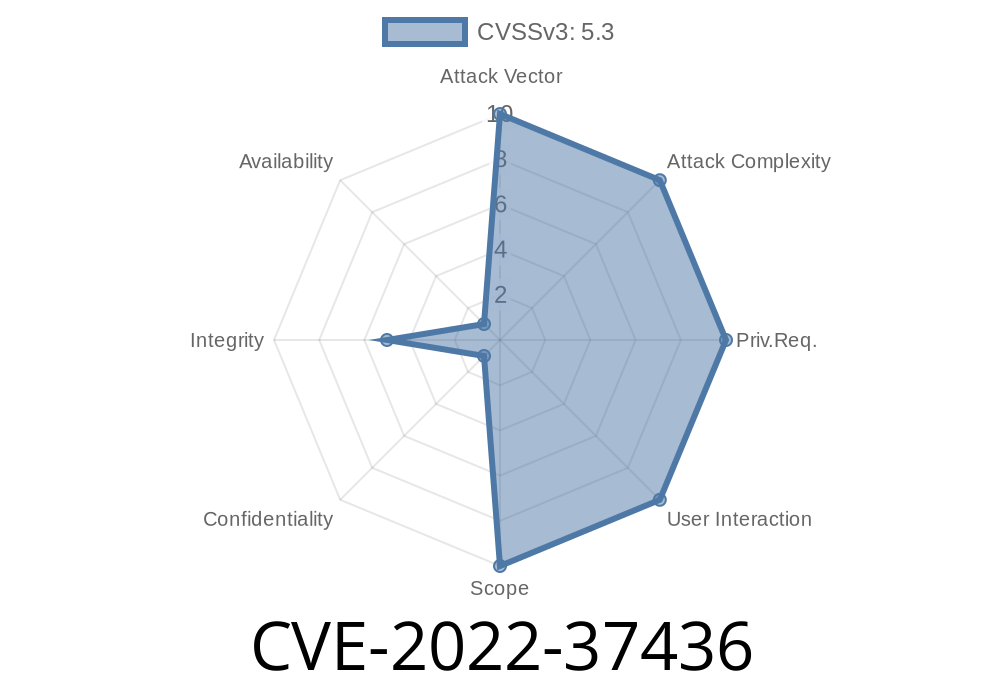CVE-2022-37436 is a security vulnerability discovered in the Apache HTTP Server, versions prior to 2.4.55. The exploit, caused by a malicious backend, results in the truncation of response headers and potential security risks associated with headers incorporated into the response body. This blog post examines the cause of the vulnerability, the risk associated with it, and the possible mitigation techniques. We'll discuss code snippets, refer to original sources, and provide an overview of how the vulnerability can be exploited.
Background
Apache HTTP Server is one of the most widely used web servers globally, making this vulnerability significant due to its vast user base. The vulnerability exists when a malicious backend server manages to truncate the response headers, causing some headers to be merged into the response body instead of being processed as separate header entities. As a result, headers with essential security functions are not interpreted correctly, leading to potential security breaches and data leaks.
Exploit Details
The vulnerability presents itself when the response headers are parsed in the mod_proxy module of the Apache HTTP Server. In the process of reading the response from the backend server, if the response headers are truncated, the Apache HTTP Server does not handle the truncation correctly. This causes a part of the response headers to spill into the response body, making the security headers non-functional.
An attacker can craft a malicious backend server that deliberately truncates the response headers, thereby compromising the intended behavior of the Apache HTTP Server. Below is an example of a request and response illustrating the vulnerability:
Request
GET /vulnerable-page HTTP/1.1
Host: www.example.com
Response
HTTP/1.1 200 OK
Content-Type: text/html
Content-Length: 100
First-Part-Of-Security-Header: important-security-value, Second-Part-of-Security-Header: crucial-security-value
Truncated-Header:
<body>
...remaining HTML content...
</body>
In the above response, the "First-Part-Of-Security-Header" and "Second-Part-of-Security-Header" should be separate headers, but due to the truncation, they become part of the response body.
Links to Original References
1. Official Apache HTTP Server advisory: https://httpd.apache.org/security/vulnerabilities_24.html
2. CVE Details Page: https://nvd.nist.gov/vuln/detail/CVE-2022-37436
Mitigations
As mentioned at the beginning of the post, the vulnerability has been rectified in version 2.4.55 of the Apache HTTP Server. Therefore, updating to the latest version is the most straightforward mitigation technique. Apache provides a detailed guide on upgrading your server, which can be found here: https://httpd.apache.org/docs/2.4/upgrading.html
For those who cannot upgrade immediately, other possible workarounds include
- Implementing additional input validation on the backend server to ensure that responses are well-formed and do not contain any maliciously injected data.
- Using security tools such as Web Application Firewalls (WAFs) to detect and prevent malformed responses from reaching client browsers.
Conclusion
CVE-2022-37436 highlights the importance of keeping your Apache HTTP Server updated and understanding the potential impacts of security vulnerabilities. Although upgrading to the latest version of Apache resolves this particular issue, it is essential to foster a healthy security posture by actively monitoring the latest security advisories, testing new releases, and applying security best practices. Stay safe!
Timeline
Published on: 01/17/2023 20:15:00 UTC
Last modified on: 01/25/2023 01:58:00 UTC
